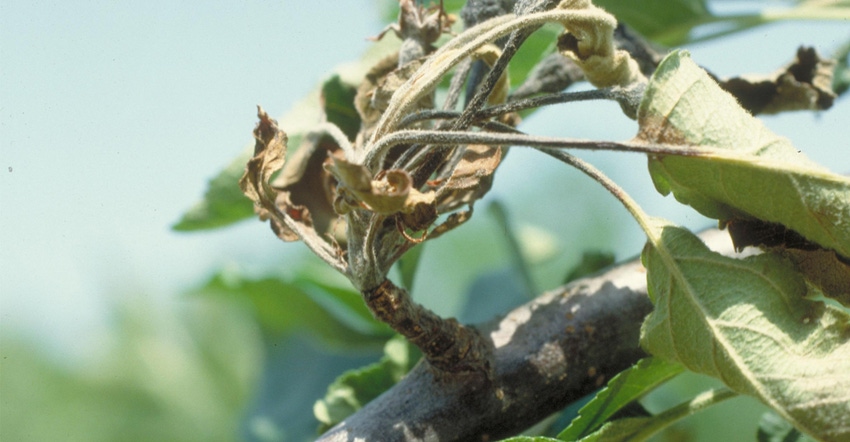February 26, 2020

By George W. Sundin
Prohexadione-calcium is a growth inhibitor that we have known for years to provide excellent control of the shoot blight phase of fire blight. The Sundin lab at Michigan State University has worked on determining the mechanism of action of ProCa in shoot blight control for the past several years.
First, we eliminated the possibility that ProCa induced the tree to produce a compound(s) inhibitory to the fire blight pathogen. Ultimately, we began assessing the possibility that ProCa induces trees to produce a physical barrier to fire blight infection.
We began examining cell walls in leaves taken from shoot tips of Gala apple trees either treated with or not treated with ProCa at a high rate (12 ounces per 100 gallons). The ProCa effect on shoot blight control becomes apparent about 10 to 14 days after application.
We analyzed leaf cross-sections using conventional microscopy and scanning electron microscopy. The SEM studies allowed us to obtain a close-up view of what was happening at the shoot tip.
What we consistently observed were cortical parenchymal cells from ProCa-treated shoots with thickened cell walls compared to those from nontreated shoots. In addition, most of the ProCa-treated leaves also contained additional areas or layers of material surrounding the vascular tissue.
We measured the width of thousands of cell walls from leaf midvein cortical parenchmya tissue and found some interesting results. Cell wall widths from the tips of the youngest leaf of the shoot averaged 1.17 micrometers, compared to 2.36 micrometers from ProCa-treated leaves.
For reference, 1.17 micrometers equals 0.000117 centimeters equals 0.000046 inches, which is very small, but at the microscopic level, very important. Thus, ProCa treatment doubled the cell wall width. Granted, this doesn’t sound like much, but from the perspective of the fire blight bacterium, it is huge.
Bacterial pathogens such as the fire blight pathogen produce a needle-like apparatus that they use to cause disease. From other lab research we’ve done, we know that the fire blight pathogen must infect living cells to initiate the process that ends in a shoot blight infection.
The needle-like apparatus necessary for disease was examined by Dr. Sheng Yang. His group at MSU found it to be about 2 micrometers long. Since ProCa-treated apple shoots had average cell wall widths that exceed 2 micrometers, this suggests the bacterial needle is not long enough to cross the plant cell wall and allow infection to proceed.
We believe that this cell wall physical barrier provides the mechanistic basis for shoot blight control. We also determined that the cell wall widths are not quite thick enough at seven days after ProCa treatment. This also correlates with our knowledge that it takes about 10 to 14 days after application for the ProCa effect to become apparent.
With highly susceptible cultivars, ProCa remains the best option for fire blight shoot blight management and has many times helped avoid epidemic outbreaks. Furthermore, it should be remembered that ProCa treatment controls both streptomycin-resistant and streptomycin-sensitive strains of the fire blight pathogen.
Sundin is a professor at Michigan State University’s Center for Integrated Plant Systems. He can be reached at [email protected].
Source: Michigan State University, which is solely responsible for the information provided and is wholly owned by the source. Informa Business Media and all its subsidiaries are not responsible for any of the content contained in this information asset.
You May Also Like




